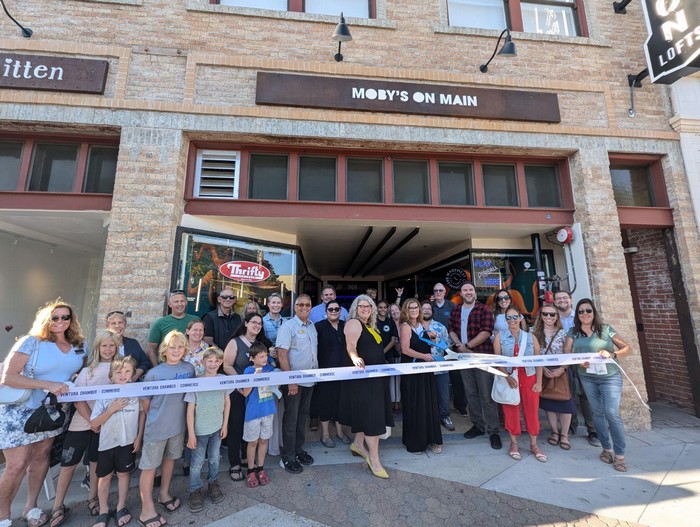Eileen Doyle enjoying the Breeze in Venice, Italy
All posts by admin
Call to Artists: Beautifying Trash Bins Public Art Project
The City invites artists and artistic teams to participate in the Beautifying Trash Bins Public Art Project, an initiative to transform four new “bear box” style trash receptacles into vibrant works of art. This project aims to deter vandalism, enhance the visitor experience at the beach, pier, and promenade, promote cleanliness, and celebrate Ventura’s natural beauty and historical coastal landmarks. It also seeks to foster a sense of community and environmental stewardship.
This project is a collaboration between the City’s Environmental Sustainability Division and the Arts & Culture section.
Key Dates:
- Call to Artists Opens: Tuesday, August 27, 2024
- Application Submission Deadline: Friday, September 13, 2024, by 5:00 p.m.
- Panel Review of Applications: Mid to Late September 2024
- Arts & Culture Commission Shortlist Review & Selection: October 10, 2024
- Project Execution: TBD
Don’t miss this unique opportunity to contribute to Ventura’s public art landscape!
https://www.cityofventura.ca.gov/2537/Public-Art-Opportunities
Fantastical Blues
Solo Show by Deborah Paulsen
Longtime artist and art instructor Deborah Paulsen will present her first Buenaventura Art Association solo exhibition Sept. 6 – Oct. 26 in Studio 99, BAA’s Ventura headquarters in Bell Arts Factory, 432 N. Ventura Ave.
Using hot beeswax and damar resin with added shellac, oil paints and pigment sticks, she creates encaustic paintings on cradled wooden panels and will display about 18 works in a show titled “Fantastical Blues.”
Paulsen will be on hand to discuss her art and the encaustic process at First Friday receptions 6 – 9 p.m. Sept. 6 and Oct. 4 and during Ventura’s annual weekend ArtWalk, noon-5 p.m. Sept. 21 and 11 a.m.-4 p.m. Sept. 22. https://www.buenaventuraartassociation.org.
Chamber Ribbon Cutting at Moby’s on Main
Photo by Ashley Pope
Moby’s on Main enjoyed a Chamber Ribbon Cutting and Public Open
House on Aug. 22. See their Business Profile from the 6/26 issue:
https://venturabreeze.com/2024/06/26/business-profile-mobys-on-main-now-open/
Ventura Artwalk Sept. 21-22
Ventura Artwalk: Sat, Sept. 21, 12 – 5 pm and Sun, Sept. 22, 11 am – 4 pm. Downtown.
The family-friendly event will feature hundreds of artists in local galleries, businesses, restaurants and on the grounds of Mission Park and the Albinger Museum. Artist booths, popular local bands, aerialists, poetry, dance, a film festival, street painting, puppetry and a children’s area will all be a part of this event run by an enthusiastic all-volunteer team. Live painting and pottery demonstrations will also be featured. This huge, free event unites Ventura’s west side neighborhoods, businesses and arts community in a two-day celebration of the creative spirit. Transit to ArtWalk Ventura and along the route will again be at no cost through the generosity of Gold Coast Transit. Register to participate at www.artwalkventura.org.
Visit Ventura Honored with U.S. Travel Association Award for Collaboration with Key Stakeholders and Local Community
Visit Ventura receives their first U.S. Travel Association award for Community Engagement during X Games 2023. Visit Ventura collaborated and got creative with state, county, and local stakeholders to promote the X Games and engage the local community in the celebration.
For the first time, Visit Ventura received the U.S. Travel Association ESTO Destiny Award for Community Engagement during X Games 2023
Visit Ventura is extremely proud to announce that they are a recipient of the U.S. Travel Association 2024 ESTO Destiny Award, winning the Community Engagement award for their creativity and collaboration with key stakeholders, small business owners, and the community to celebrate the X Games across Ventura, weaving the international sports event into the fabric of the town. This is the first ESTO Destiny Award Visit Ventura has received.
The award was presented at the U.S. Travel Association’s 40th annual ESTO conference —which recognizes U.S. Travel destination and state tourism office members for excellence and creative accomplishment in destination marketing— where over 1,000 attendees representing states, regions, and cities from all over the nation attended.
“Judges noted that this campaign was a success story to rival all others with all of the tactics precisely on target. Building a foundation with a partnership between the X Games, the city, county, and state, they had local businesses embrace the games,” said ESTO awards emcee Sally Hogshead at the ceremony.
Visit Ventura was the only California destination in its category, among the other finalists for the Community Engagement award included Visit Austin, Visit Mesquite, and Travel South USA. Visit Ventura was one of only three California destinations that won an ESTO Destiny award this year.
The Community Engagement category was judged on how the destination marketing organization demonstrated its value to stakeholders, how local businesses and tourist attractions were supported by the tourism office, and how the tourism office collaborated with and involved smaller attractions and local businesses.
Visit Ventura worked with over 40 local businesses in a city-wide initiative creating limited beer —that was sold on Amtrak trains— and cocktails releases, food items, and other products to showcase the creativity and passion of local businesses to locals, visitors, and X Games athletes alike. Members of the Chumash tribe performed X Games’ first-ever traditional blessing in front of athletes and media, and local events brought the entire community together to celebrate the X Games.
“These two words —Community Engagement— have guided our daily drive to build economic vitality for Ventura while supporting our local businesses and celebrating a global event happening in OUR Ventura!” said Visit Ventura President and CEO Marlyss Auster. “I am so proud that the U.S. Travel Association has recognized our efforts to collaborate with our partners on the state, county, and local level to host a successful international event on our slice of the California coast playground.”
Uniting Ventura Through Art: The Ventura Mandala Project
The Ventura Mandala Project is set to transform the intersection of Main St. and Figueroa St. during the upcoming ArtWalk Ventura festival, creating a lasting legacy for the city. This collaborative endeavor, led by Ojai community artist River Sauvageau, is designed to captivate hearts and minds while fostering connection, inclusivity, and pride within Ventura.
What is the Ventura Mandala Project?
Inspired by the ancient tradition of mandala-making and the 30+ years of Ojai Day Mandalas, the Ventura Mandala Project invites residents of all ages and backgrounds to come together to co-create a stunning 40-foot diameter mandala on the streets of downtown Ventura.
Key Features:
- Location: Main St. at Figueroa St., a bustling intersection that anchors Ventura’s vibrant arts scene.
- Timing: Painting will take place on Thursday and Friday, September 19 & 20, from 10 a.m. to 5 p.m., coinciding with the ArtWalk Ventura Festival 2024 and tapping into the event’s energy and excitement.
- Collaboration: Residents, artists, visitors, community leaders, and festival-goers will join forces to paint the mandala, infusing it with diverse perspectives, stories, and symbols.
- Symbolism: The mandala will symbolize unity, diversity, and shared identity, reflecting Ventura’s rich cultural heritage.
Why Participate?
- Community Engagement: Connect with fellow residents through a meaningful and collaborative art-making experience.
- Cultural Celebration: Honor Ventura’s diversity and heritage by contributing to a visual masterpiece that represents our collective story.
- Artistic Expression: Unleash your creativity and leave your mark on the city’s streetscape, turning ordinary pavement into a vibrant work of art. All abilities are welcome, and local artists are especially encouraged to participate.
- Legacy Building: Create a lasting legacy for future generations, embodying the spirit of unity and creativity that defines our community.
- Family Unity: Bring your family to paint together, continuing a tradition where multiple generations collaborate on the mandala.
How to Get Involved:
- Join Our Team: Email River at [email protected] or text 805-669-8058 to contribute your unique vision to Ventura’s Mandala Project. Whether you want to paint, assist at the paint table, or support the team with your presence, there’s a role for everyone.
- Spread the Word: Invite friends, family, and neighbors to join in, amplifying the impact of this community-driven initiative.
- Check In: On the day of the event, visit the paint table to be welcomed and guided into the painting process.
For more information, visit https://studio-sauvageau.myshopify.com/pages/mandala-movement
Interested in Painting a Public Art Mural? Here’s How to Get Started
Ventura’s vibrant public art scene is constantly evolving, with more murals being added each year. If you’re planning to install a mural, you’ll need to obtain a City permit in the following cases:
- The mural will be on private property and visible from public areas (e.g., sidewalks, streets).
- The mural will be on or inside City-owned property.
- The mural will be in a Historic District or on a Historic Landmark.
The permitting process is outlined in the Public Art Mural Application Packet, which you can access below. The Community Partnerships Division within the Parks & Recreation Department is also available to assist you through the review and approval process.
Learn more and get started by completing the online form: https://www.cityofventura.ca.gov/1778/Public-Art-Murals
Amazon launches its first-ever Disaster Relief Hub in California
In response to the growing wildfire crisis across the state, Amazon is launching its first-ever Disaster Relief Hub in California, and first hub dedicated to wildfire relief in the U.S. Strategically located in San Bernardino Valley, this first-of-its kind disaster relief hub that leverages Amazon’s logistics to store and deliver critical supplies to impacted communities as quickly as possible.
As climate change accelerates the frequency and intensity of wildfires worldwide, Amazon is enhancing its disaster relief capabilities in the communities where we operate.
The United Nations projects a 14% increase in extreme wildfires by 2030 due to climate change. Having a dedicated facility where these items are ready to be shipped allows Amazon to send help in less than 72 hours, much faster than if teams had to pack and consolidate the products from different facilities across the country.
With the help of relief organizations working in wildfire-impacted regions, including American Red Cross, Good 360, After The Fire, and All Hands All Heart, we leveraged our data and their forecasts to stock the Hub with products that households and individuals need as they return to their communities after a fire.
The more than 6,000 stored items include wildfire mitigation equipment such as axes, goggles, masks, rakes, shovels, smoke pumps, and soil sifters; and personal supplies including fire-safe rubber boots, high-particulate matter filtration respirators, hydration packets, neck gaiters, specialized gloves, trauma kits, and more.
The hub’s inventory has been meticulously curated in partnership with non-profit organizations working directly in wildfire-affected regions. www.aboutamazon.com/news/community/amazon-wildfire-disaster-relief.







